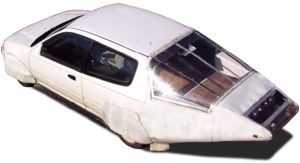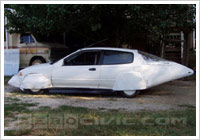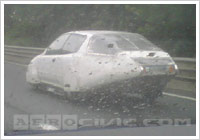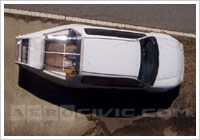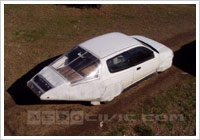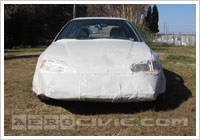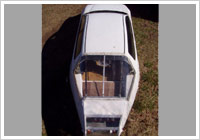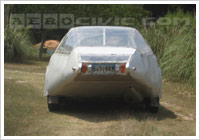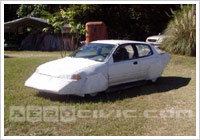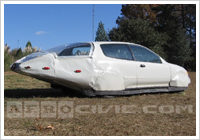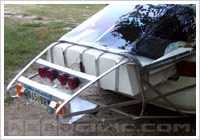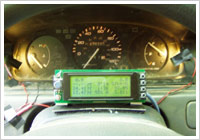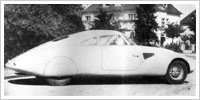« Test Plane Crashes Don't Deter Cessna | Main
First Look at Tesla's Stunning Model S
Los Angeles — Tesla Motors' Model S is a stunningly beautiful car that that builds upon the cachet of the Roadster and proves the company is serious about pushing electric vehicles into the mainstream.
Company CEO Elon Musk compared the luxury and practicality of his car to the BMW 5 series and Mercedes Benz CLS sedans and said history will place it alongside the Ford Model T. His car, he said, is that important and will play a similar role in reshaping the auto industry.
"This is one of the most historic cars," Musk said moments before pulling a black sheet off a silver prototype of the Model S, which the company all but swears will be in driveways by the third quarter of 2011. "We are trying to accelerate the EV revolution and get us off oil."
Musk's hyperbole aside, the Model S is as important to the company as it is gorgeous to behold. Getting it built will prove Tesla is more than a niche player, help push EVs into the mainstream and give Tesla a strong position in the emerging electric-car market. But perhaps more than that, a seven-passenger sedan with a range of up to 300 miles will prove EVs can be sexy and practical.
"It's fantastic. Fantastic," said Chris Paine, director of the film Who Killed the Electric Car. "A lot of people ask if electric cars can be practical. This car is definitely practical. It's a remarkably important car. This car shows that it can be done and it will be done."
The Model S will have a list price of $57,400, but the $7,500 federal tax credit for EVs and plug-in hybrids will bring that down to $49,900.
But bringing the car to market by 2011 won't be easy, and Tesla has no time to lose. General Motors, Ford and Nissan are among the major automakers promising to have EVs on the road by then, and Tesla also is facing competition from a growing number of startups, including Fisker Automotive.
Musk isn't worried.
 "I hope the Volt is out," he said. "I hope Nissan has its car. I hope everyone has an electric car. The most we can do as a company is serve as an example to the auto industry. We want to accelerate the adoption of electric cars."
"I hope the Volt is out," he said. "I hope Nissan has its car. I hope everyone has an electric car. The most we can do as a company is serve as an example to the auto industry. We want to accelerate the adoption of electric cars."
The sleek car is clearly influenced by European aesthetics. It's long and low, with an aggressive stance and a muscular look. The styling, by Franz von Holzhausen — who designed the Pontiac Solstice and Saturn Sky, and then worked for Mazda before joining Tesla — drew widespread praise. There were few in the room who didn't want to drive it. Only prospective customers were taken for a short spin down the street.
"Oh my god," said Paul Scott, a founder and board member of the EV advocacy group Plug In America. "I went in with high expectations, and my expectations were exceeded. The car's gorgeous. I love it. I picture myself in this car and I really want one."
The car has drawn comparisons to the Jaguar XF and the Maserati Quattroporte, and although von Holzhausen didn't cite those vehicles as influences, he welcomed the association.
"I hear Jaguar, Aston Martin, Alfa Romeo, and I think that's positive," he said. "People have positive associations with those brands, and I think that's a good reflection on Tesla. If they said it reminds them of the (Ford) Pinto or the (Pontiac) Aztek, we'd have problems."
Von Holzhausen said it was important to make the car athletic but not brawny and give the car a sense of lightness and efficiency.
"The inspiration is more Lance Armstrong than Lou Ferrigno," he said.
That's not to say the car lacks muscle. Tesla is going head-to-head with the likes of BMW, Mercedes, Audi and Jaguar with the Model S, which means the car's gotta perform as well as it looks. To that end, Tesla is developing a drivetrain that builds upon the technology underpinning the Roadster.
The Model S will use a liquid-cooled motor with a peak output of 300 kilowatts, or about 402 horsepower. Thats a significant hike over the Roadster, which puts out 248 horsepower. Of course, the Model S is a significantly bigger car — it's expected to weigh about 4,000 in production trim — and it will be a family car, which means it needs to be able to haul all the stuff a family hauls.
"We wanted to make sure that when you load the car up, you can still get over the Grapevine," J.B. Straubel, chief technology officer, said, referring to the mountain pass that separates Los Angeles from points north. "It increases real-world usability."
Power comes from a lithium-ion battery pack with either 5,500 or 7,800 cells. It weights "about 500 kilos," or roughly 1,100 pounds. Customers can choose from three packs that will deliver 160 to 300 miles per charge — with the cost of the pack rising with the range it provides. Scott, the EV advocate, called it a brilliant move.
"While it's great to have 250 or 300 mile range, it's completely unnecessary for most people, and you're paying for that," he said. Giving people the option of a 160-mile version, a 230-mile version or a 300-mile version is a great idea."
Musk said the 300-mile version of the battery will have a "quick charge" feature that will allow it to be recharged in 45 minutes, although he didn't offer any details. He said advances in the battery chemistry and construction increased volumetric efficiency over the Roadster's pack by 50 percent.
The battery pack is laid out along the floorboard of the car, and the motor and electronics module sit between the rear wheels, creating a large, open interior. Musk made maximizing practicality a prime directive in designing the car, and he made a point of noting how much space the interior — which is luxuriously decked out in a few acres of leather and wool — provides. He wouldn't let us try it, but Musk insists you can fit a mountain bike in the back without removing the wheels, provided you put the back seats down, and he said the car will carry a 50-inch TV. There's also a flip-up rear-facing seat at the back of the car that's big enough to carry two small kids — hence the seven-passenger designation.
"It's just like the old station wagons from the '70s with the seat in the back," Musk said. "It's there for the occasional trip."
Tesla will have its work cut out for it meeting the 2011 deadline, and just about everything will have to go Tesla's way. Aside from lining up suppliers and navigating the government regulatory maze, Tesla still has to build a factory to assemble the car. Musk says the company is close to finalizing a deal for a factory in Southern California, but he wouldn't offer specifics. He's also confident the Department of Energy will come through with a $350 million loan to get the factory up and running. And if Tesla doesn't get the loan? Musk says he'll figure something out.
"There should be no question that we'll make this car," he said emphatically. "This is the beginning of a new era in transportation."
More hyperbole to be sure, but you can't discount it entirely because Tesla has an advantage over the big automakers — it already knows how to build an electric car that works. There are more than 250 Roadsters in driveways right now.
"You have to give Tesla the benefit of the doubt," said Aaron Bragman, an auto industry analyst with I.H.S. Global Insight. "It's the only company actually producing an electric vehicle right now. At the moment, Tesla has the halo."
Photos: Jim Merithew/Wired.com












